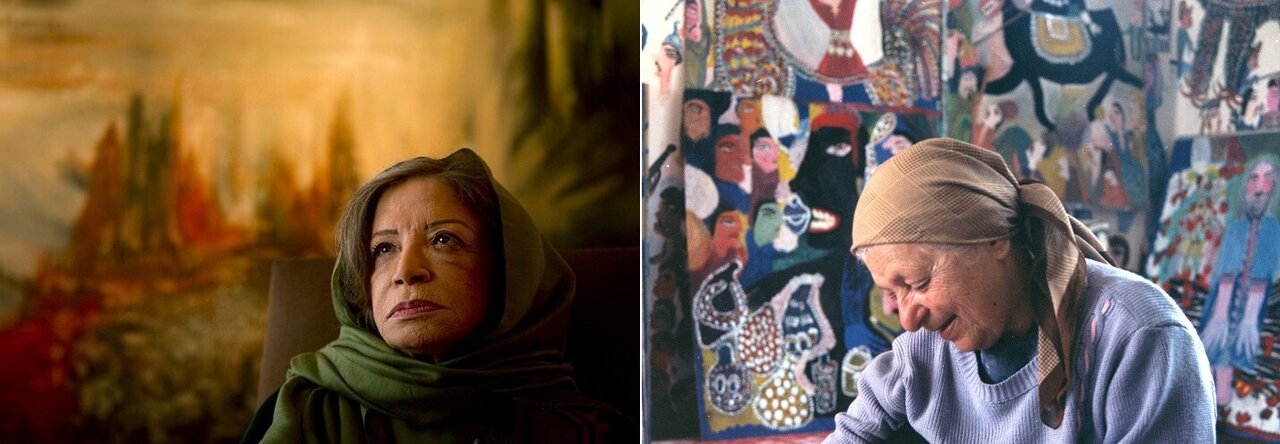TMoCA cinematheque to show documentaries about Iranian women artists

TEHRAN – Concurrent with the “In Women's Words” exhibition at the Tehran Museum of Contemporary Art (TMoCA), the museum's cinematheque will present a weekly screening program featuring documentaries focused on women, society, and art.
The program opens on Sunday with the screening of two documentaries: “How Strange Is Love, Which Is Pain and Cure” directed by Keyvan Alimohammadi and Omid Bonakdar, and “Mokrrameh, Memories and Dreams” by Ebrahim Mokhtari, Mehr reported.
“How Strange Is Love, Which Is Pain and Cure” is a 20-minute experimental and poetic film offering a multi-layered narrative on the life of the renowned late artist Iran Darroudi, exploring themes of pain, liberation, and self-discovery.
Iran Darroudi (1936-2021) was a prominent Iranian modern artist. Her work is characterized by surreal paintings that incorporate Iranian-themed imagery and striking lighting effects. Over the years, Darroudi divided her time between Tehran and Paris, where she developed her distinctive artistic style. Her contributions to modern art have left a lasting impact on the Iranian art scene.
Born in Mashhad, Khorasan Razavi Province, Darroudi studied history of art at the École du Louvre in Paris, stained glass at the Royal Academy of Brussels, and television direction and production at the RCA Institute in New York.
Her first solo exhibition was held in Miami in 1958 at the invitation of the Florida State Art Center. Her works have been displayed at Tehran Museum of Contemporary Art, LA University in Los Angeles, Virginia Tech University in Virginia, the United Nations in New York, La Galleria Gallery in Mexico, Miami Beach Art Center in Florida, Atrium Artist Gallery in Geneva, and Galarie 21 in Zurich.
In addition to her painting career, Darroudi wrote articles on the history of art and art criticism for the Iranian newspaper Kayhan.
In 1968, she created a 55-minute documentary about the Venice Biennial and was appointed an honorary professor at the Industrial University of Tehran, where she taught art history.
In 1976, Darroudi exhibited at the Mexican Museum of Art, where the Spanish painter Antonio Rodríguez Luna acclaimed her as one of the world's four greatest painters.
“Mokrrameh, Memories and Dreams” is a 48-minute documentary, which tells the story of Mokarrameh Ghanbari, a self-taught, rural woman from northern Iran, who began painting in the final years of her life without any formal artistic training.
Born in Dari Kandeh village in the northern Babol County, Mazandaran Province, Mokarrameh began painting at the age of 63 in 1991.
Despite her great talent, Mokarrameh never received any formal training in painting. She used bright, original colors inspired by the beautiful natural surroundings of her neighborhood as well as her memories and dreams in her art.
She took on painting as a way to express her feelings when her children, concerned for her health, would no longer allow her the farm work and cow herding she enjoyed.
The widowed Mokarrameh, then in her early 60s, spent her time caring for the cows that she loved and doing farm work, until she became very ill and had to go to Tehran for medical care. While she was sick in bed, her children, who were concerned about her health, sold the cows to reduce her workload. But their well-meaning act sent her into a depression. Her first painting was a portrait of one of the cows she missed so much.
A friend gave her paper and colored pencils to express herself, and she immediately began to draw obsessively. For four years, she kept her art a secret out of fear of what her neighbors would think. She painted late at night and hid her work if anyone came into her home. But her creative spirit would not be suppressed. Her work found its way onto the walls of her home, her stove, and the back of discarded wallpaper. When he discovered her new passion, her son brought her 50 sheets of paper and she soon covered both sides of them all, making her own paint of natural dyes when she ran out of the store-bought kind.
Within a few years, her works were being recognized by painters in Iran and overseas. For the first time in 1995, her paintings were exhibited at Tehran’s Seyhun Gallery, with follow-on exhibits in 1996, 1997, 1998, and 2005.
Her works have been compared with the paintings of Russian-born French surrealist Marc Chagall (1887-1985). They have been exhibited at over 40 exhibitions in Iran and other countries, including the Bowers Museum in California.
In 2001, Ghanbari was awarded an honorary certificate at the Conference of the Foundation of Iranian Women’s Studies in Stockholm and was named the year’s exemplary woman. In addition, she was named the “Female Painter of 2001” by the Swedish National Museum.
She died at the age of 77 in 2005 and was buried in the courtyard of her house. After her death, her house was registered as a museum by the Iran Cultural Heritage, Handicrafts and Tourism Organization to preserve her artworks.
The film screenings will take place every Sunday at 4 p.m. in the museum’s cinema hall. The TMoCA is located on North Kargar Street, next to Laleh Park. Admission is free and open to the public.
Launched on July 23, the “In Women’s Words” exhibition is dedicated to showcasing 121 works by modern Iranian women artists.
Curated by Afsaneh Kamran, Toka Maleki, and Sajjad Baghban Maher, the exhibition displays works by artists such as Monir Farmanfarmaian, Behjat Sadr, Parvaneh Etemadi, Farideh Lashai, and Leyly Matin Daftari, among others.
SS/
Leave a Comment